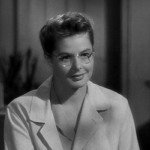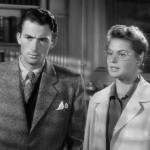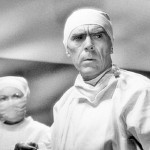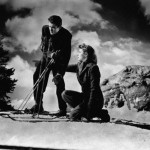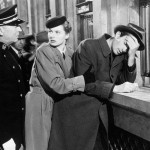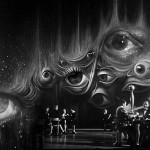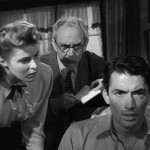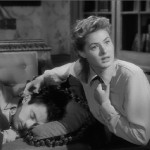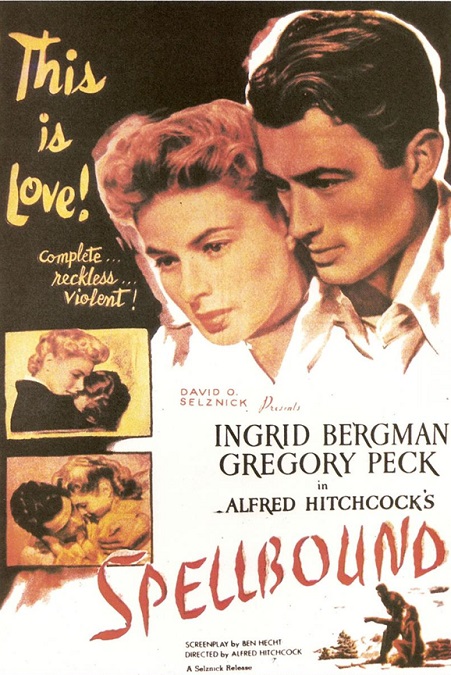
Spellbound – 1945
Hmmm… There were two sides to this movie. One was very good and the other was very bad. Spellbound was a collaboration between two very famous men, Alfred Hitchcock and Salvador Dali, both of whom were butting heads with the film’s producer David O. Selznick. The brief synopsis given on the Netflix website describes Spellbound as one of Hitchcock’s finest films. I’m sorry, but I beg to differ.
This movie was, in fact, a poor example of Hitchcock, partly because of Selznick’s involvement, and partly because of an unrealistic script. The producer’s job is with the film’s finances, not its story-telling, its artistic style, or the creative vision that the director brings to the project. Hitchcock was known as an innovative and brilliant director, well respected in Hollywood. Dali was one of the most famous surrealistic artists in the world. One of the best parts of the film was a 20 minute dream sequence that was designed by Dali and directed by Hitchcock. It was the product of not one, but two geniuses. Selznick cut it down to two minutes. Shame on you, Selznick!
Ingrid Bergman once again takes the lead, playing Dr. Constance Peterson, a brilliant and beautiful young psychoanalyst working at Green Manors, a prominent mental hospital. The hospital’s director, Dr. Murchison, played by Leo G. Carroll, is retiring, though it is clear that he is being forced to step down by the facility’s board of directors. His replacement, Dr. Anthony Edwards, played by Gregory Peck, arrives and takes up his residence.
Dr. Peterson and Dr. Edwards fall instantly and hopelessly in love by the end of his first day. But the new administrator is not as he seems. It turns out that he is not a doctor at all, but a patient posing as one, after having allegedly murdering him. Sounds like a good set-up for a psychological suspense film, right?
OK, here is where I started to have issues with the film, and I’ll be honest, this wasn’t the producer’s fault. I know I’m not educated in the field of psychoanalysis, but as I was watching the movie, I was blowing holes in it, left and right. Then, after the movie was over, I did a little research to see if my issues were justified. They were.
One thing that my research uncovered which stood out to me as true, was the fact that Freudian psychoanalysis is meant to treat the sane patient, not the insane. Interpreting the dreams of an amnesiac with a crippling guilt complex which stems from a traumatic childhood experience cannot be helped by dream analysis, especially not in the space of one night.
Let me explain. Peterson and Edwards’ imposter go on the run. She inexplicably believes in his complete innocence without a shred of evidence. She also believes that if she can break through the barriers in his mind, force him to remember the traumatic events of his past, he will remember that he never killed the real Dr. Edwards at all. Reality be damned.
She ends up taking him to her former mentor and colleague, Dr. Alexander Brulov, excellently played by Russian-born actor Michael Checkov. She lies to him, telling him that they are married and he invites them to stay at his home for the night. His character was wonderful in that he saw through her feeble deception and called her on it, saying, “How stupid do you think I am?”
After one night, Edwards recounts his dream to the two doctors, and together, Peterson and Brulov use Freudian analysis to provide an instant cure. I’m sorry, but it doesn’t work that way! True mental illness takes years to treat and it isn’t like following a neatly laid-out trail of bread crumbs – one recovered memory doesn’t lead you to the next. Also, dream analysis isn’t so specific. If he sees sloping roof, it doesn’t automatically mean mountains. If he dreams of the seven of clubs in a game of 21, it isn’t a secret code for a significant event that took place at the 21 Club in New York. In essence, these doctors are horrible analysts.
Like I said, I’m not educated in the field, but even I know ridiculous and farcical writing when I see it. However, that being said, the dream sequence, or what was left of it after Selznick cut most of it out of the film, was the most visually interesting part of the movie. Dali’s surrealistic imagery and Hitchcock’s unique way of bringing the strange images to the screen were visually stunning and fascinating. Unfortunately, there are no surviving negatives of the missing 18 minutes.
In the end, the film was saved by Hitchcock’s surprise twists and the wonderful score by Miklos Rozsa, for which he won an Oscar. The movie was tolerable, but was it really Hitchcock’s finest work? I think not.
